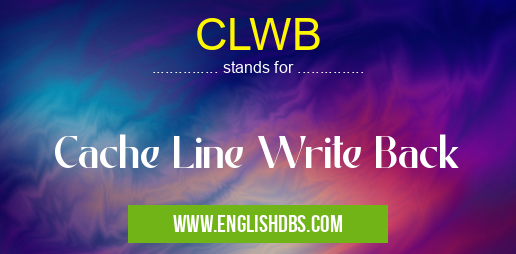What does CLWB mean in UNCLASSIFIED
CLWB (Cache Line Write Back) is a memory management instruction used in computer architecture to optimize data handling and improve performance. It is specifically designed to write back modified cache lines to the main memory, ensuring data consistency across different levels of the memory hierarchy.

CLWB meaning in Unclassified in Miscellaneous
CLWB mostly used in an acronym Unclassified in Category Miscellaneous that means Cache Line Write Back
Shorthand: CLWB,
Full Form: Cache Line Write Back
For more information of "Cache Line Write Back", see the section below.
How CLWB Works
When a processor modifies data in a cache line, it marks that cache line as "dirty." This indicates that the data in the cache line has been changed and needs to be written back to the main memory to ensure data integrity.
CLWB is used to explicitly write back a specific cache line to the main memory. It takes the address of the cache line as an argument and initiates the write-back process. The processor waits until the write-back operation is complete before proceeding with subsequent instructions.
Benefits of CLWB
- Improved Data Consistency: CLWB ensures that modified data in the cache is written back to the main memory, preventing data corruption and maintaining data integrity across different memory levels.
- Performance Optimization: By explicitly writing back dirty cache lines, CLWB helps reduce the number of write-backs that occur later during cache coherence operations. This can improve overall system performance by minimizing unnecessary write-back traffic.
- Reduced Power Consumption: Writing back dirty cache lines only when necessary can reduce power consumption by saving write operations to the main memory.
Essential Questions and Answers on Cache Line Write Back in "MISCELLANEOUS»UNFILED"
What is Cache Line Write Back (CLWB)?
Cache Line Write Back (CLWB) is a memory coherency protocol used in multi-processor systems to maintain data consistency. It ensures that all processors in the system have the most up-to-date copy of data in their caches.
How does CLWB work?
CLWB writes the contents of a cache line back to the main memory. This action invalidates the cache line in all other processors' caches, forcing them to fetch the updated data from memory the next time they access it. By doing so, CLWB ensures that all processors have a consistent view of the data.
When is CLWB used?
CLWB is typically used in situations where a processor has modified data in its cache and needs to ensure that the changes are propagated to the main memory. This is necessary before the processor allows other processors to access the data or before the system enters a power-saving state.
What are the benefits of using CLWB?
CLWB helps maintain data consistency in multi-processor systems, preventing data corruption and ensuring that all processors have access to the most up-to-date information. Additionally, CLWB can improve system performance by reducing the number of cache misses and maintaining data coherency.
What are the limitations of CLWB?
CLWB can introduce a performance overhead due to the additional memory write operation. Additionally, CLWB can increase power consumption as it forces the main memory to be accessed more frequently.
Final Words: CLWB is a valuable memory management instruction that plays a crucial role in maintaining data consistency and optimizing performance in computer systems. By explicitly writing back modified cache lines to the main memory, CLWB ensures data integrity and reduces the overhead associated with write-back operations. Its benefits make it an essential tool for improving the efficiency and reliability of modern computer systems.
